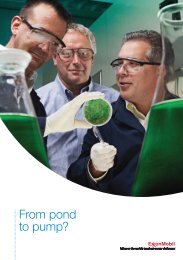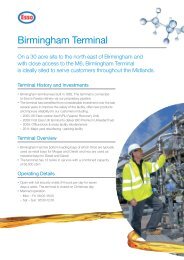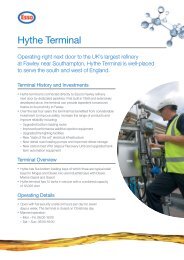Simple Guide to Oil Refining - ExxonMobil in the UK
Simple Guide to Oil Refining - ExxonMobil in the UK
Simple Guide to Oil Refining - ExxonMobil in the UK
Create successful ePaper yourself
Turn your PDF publications into a flip-book with our unique Google optimized e-Paper software.
A<strong>Simple</strong> <strong>Guide</strong><br />
<strong>to</strong> <strong>Oil</strong> <strong>Ref<strong>in</strong><strong>in</strong>g</strong><br />
We all know that mo<strong>to</strong>r oil and gasol<strong>in</strong>e<br />
come from crude oil. What many people<br />
do not realize is that crude oil is also <strong>the</strong><br />
start<strong>in</strong>g po<strong>in</strong>t for many diverse products<br />
such as clo<strong>the</strong>s, medical equipment, electronics,<br />
vitam<strong>in</strong> capsules and tires.<br />
Whe<strong>the</strong>r on land or under <strong>the</strong> ocean,<br />
crude oil comes from deep underground<br />
where <strong>the</strong> rema<strong>in</strong>s of plants and animals<br />
from millions of years ago have been heated<br />
and pressurized over time. Generally<br />
blackish <strong>in</strong> color, crude oil has a characteristic<br />
odor that comes from <strong>the</strong> presence of small<br />
quantities of chemical compounds conta<strong>in</strong><strong>in</strong>g<br />
sulfur and nitrogen. There are different<br />
grades of crude oil. Each grade has a specific<br />
composition that is determ<strong>in</strong>ed by <strong>the</strong> orig<strong>in</strong>al decomposed source<br />
materials as well as <strong>the</strong> properties of <strong>the</strong> surround<strong>in</strong>g soil or rock formations.<br />
It can be light or heavy, referr<strong>in</strong>g <strong>to</strong> density, and sweet or sour, referr<strong>in</strong>g <strong>to</strong> its<br />
sulfur content. However, <strong>in</strong> its raw state, crude oil is of little use. It must be ref<strong>in</strong>ed<br />
<strong>to</strong> make it <strong>in</strong><strong>to</strong> useable products. Depend<strong>in</strong>g on <strong>the</strong> type of crude oil, it is treated<br />
via different ref<strong>in</strong><strong>in</strong>g processes <strong>to</strong> turn it <strong>in</strong><strong>to</strong> fuels, lubricat<strong>in</strong>g oils, waxes,<br />
chemicals, plastics and many o<strong>the</strong>r products used everyday <strong>in</strong> modern<br />
society.<br />
The <strong>Ref<strong>in</strong><strong>in</strong>g</strong> Process<br />
Once discovered, drilled and brought <strong>to</strong> <strong>the</strong> earth’s surface, crude oil is transported<br />
<strong>to</strong> a ref<strong>in</strong>ery by pipel<strong>in</strong>e, ship or both. At <strong>the</strong> ref<strong>in</strong>ery, it is treated and converted<br />
<strong>in</strong><strong>to</strong> consumer and <strong>in</strong>dustrial products.<br />
Three major ref<strong>in</strong>ery processes change crude oil <strong>in</strong><strong>to</strong> f<strong>in</strong>ished<br />
products:<br />
• Separation,<br />
• Conversion, and<br />
• Purification.<br />
1<br />
Tak<strong>in</strong>g on <strong>the</strong> world’s <strong>to</strong>ughest energy challenges.
Separation<br />
SEPARATION<br />
Light on<br />
<strong>the</strong> <strong>to</strong>p.<br />
Heavy on<br />
<strong>the</strong> bot<strong>to</strong>m.<br />
Just as water goes from liquid <strong>to</strong> vapor<br />
at approximately 212°F, each type of<br />
hydrocarbon changes from liquid <strong>to</strong><br />
vapor with<strong>in</strong> a specific temperature<br />
range. In general, <strong>the</strong> more carbons <strong>in</strong><br />
a molecule, <strong>the</strong> higher its boil<strong>in</strong>g po<strong>in</strong>t.<br />
This allows for separation with<strong>in</strong> <strong>the</strong><br />
distill<strong>in</strong>g process.<br />
Crude <strong>Oil</strong><br />
The first step is <strong>to</strong> separate <strong>the</strong> crude oil <strong>in</strong><strong>to</strong> its naturally occurr<strong>in</strong>g components. This is<br />
known as separation and is accomplished by apply<strong>in</strong>g heat through a process<br />
called distillation.<br />
Separation is performed <strong>in</strong> a series of distillation <strong>to</strong>wers, with <strong>the</strong> bot<strong>to</strong>m product from<br />
each <strong>to</strong>wer feed<strong>in</strong>g <strong>the</strong> next. A furnace <strong>in</strong> front of each distillation <strong>to</strong>wer heats and<br />
vaporizes <strong>the</strong> crude oil mixture. The vapor and liquid mixture is <strong>the</strong>n fed <strong>in</strong><strong>to</strong> <strong>the</strong><br />
bot<strong>to</strong>m section of <strong>the</strong> <strong>to</strong>wer. The feed section is <strong>the</strong> hottest po<strong>in</strong>t <strong>in</strong> <strong>the</strong> distillation<br />
<strong>to</strong>wer and can reach as high as 750 degrees Fahrenheit.<br />
Components that are still liquid at this elevated temperature become <strong>the</strong><br />
<strong>to</strong>wer’s bot<strong>to</strong>m product. Components that are <strong>in</strong> vapor form rise up <strong>the</strong> <strong>to</strong>wer<br />
through a series of distillation stages. The temperature decreases as <strong>the</strong> vapors<br />
rise through <strong>the</strong> <strong>to</strong>wer and <strong>the</strong> components condense.<br />
The “yield” from a distillation <strong>to</strong>wer refers <strong>to</strong> <strong>the</strong> relative percentage of each of<br />
<strong>the</strong> separated components, know as “product streams.” This will vary accord<strong>in</strong>g <strong>to</strong> <strong>the</strong><br />
characteristics of <strong>the</strong> crude be<strong>in</strong>g processed. Because a liquid’s boil<strong>in</strong>g po<strong>in</strong>t decreases at<br />
lower pressures, <strong>the</strong> f<strong>in</strong>al distillation steps are performed <strong>in</strong> a vacuum <strong>to</strong> maximize liquid<br />
recovery. Products from <strong>the</strong> distillation <strong>to</strong>wer range from gases at <strong>the</strong> <strong>to</strong>p<br />
<strong>to</strong> very heavy, viscous liquids at <strong>the</strong> bot<strong>to</strong>m. In all cases, <strong>the</strong>se product<br />
streams are still considered “unf<strong>in</strong>ished” and require fur<strong>the</strong>r process<strong>in</strong>g<br />
<strong>to</strong> become useful products.<br />
Conversion<br />
CONVERSION<br />
What a<br />
barrel of<br />
crude oil makes.<br />
Product Gallons per Barrel<br />
Gasol<strong>in</strong>e 19.4<br />
Distillate Fuel <strong>Oil</strong> 9.7<br />
(Includes both home<br />
heat<strong>in</strong>g oil and diesel fuel)<br />
Kerosene-Type Jet Fuels 4.3<br />
Coke 2.0<br />
Residual Fuel <strong>Oil</strong> 1.9<br />
(Heavy oils used as fuels<br />
<strong>in</strong> <strong>in</strong>dustry, mar<strong>in</strong>e<br />
transportation, and for<br />
electric power generation)<br />
Liquefied Ref<strong>in</strong>ery Gases 1.9<br />
Still Gas 1.8<br />
Asphalt and Road <strong>Oil</strong> 1.4<br />
Petrochemical Feeds<strong>to</strong>cks 1.1<br />
Lubricants 0.5<br />
Kerosene 0.2<br />
O<strong>the</strong>r 0.4<br />
Source: API<br />
Rearrang<strong>in</strong>g<br />
<strong>the</strong> molecules<br />
<strong>to</strong> add value.<br />
Distillation separates <strong>the</strong> crude oil <strong>in</strong><strong>to</strong> unf<strong>in</strong>ished products. However, <strong>the</strong> products do not<br />
naturally exist <strong>in</strong> crude <strong>in</strong> <strong>the</strong> same proportions as <strong>the</strong> product mix that consumers demand.<br />
The biggest difference is that <strong>the</strong>re is <strong>to</strong>o little gasol<strong>in</strong>e and <strong>to</strong>o much heavy oil naturally<br />
occurr<strong>in</strong>g <strong>in</strong> crude oil. That is why conversion processes are so important. Their primary purpose<br />
is <strong>to</strong> convert low valued heavy oil <strong>in</strong><strong>to</strong> high valued gasol<strong>in</strong>e.<br />
All products <strong>in</strong> <strong>the</strong> ref<strong>in</strong>ery are based on <strong>the</strong> same build<strong>in</strong>g blocks, carbon and<br />
hydrogen cha<strong>in</strong>s, which are called hydrocarbons. The longer <strong>the</strong> carbon cha<strong>in</strong>, <strong>the</strong><br />
heavier <strong>the</strong> product will be. Convert<strong>in</strong>g heavier hydrocarbons <strong>to</strong> lighter hydrocarbons<br />
can be compared <strong>to</strong> cutt<strong>in</strong>g a l<strong>in</strong>k on a steel cha<strong>in</strong> <strong>to</strong> make two smaller<br />
cha<strong>in</strong>s. This is <strong>the</strong> function of <strong>the</strong> Fluidized Catalytic Crackers (FCCs),<br />
Cokers and Hydrocrackers. In addition <strong>to</strong> break<strong>in</strong>g cha<strong>in</strong>s, <strong>the</strong>re are times<br />
when we want <strong>to</strong> change <strong>the</strong> form of <strong>the</strong> cha<strong>in</strong> or put cha<strong>in</strong>s <strong>to</strong>ge<strong>the</strong>r. This is<br />
where <strong>the</strong> Catalytic Reformer and Alkylation are necessary. Specialized catalysts<br />
are of critical importance <strong>in</strong> most of <strong>the</strong>se processes.<br />
The FCC is usually <strong>the</strong> key conversion unit. It uses a catalyst (a material that helps<br />
make a chemical reaction go faster, occur at a lower temperature, or control which reactions<br />
occur) <strong>to</strong> convert gas oil <strong>in</strong><strong>to</strong> a mix of Liquified Petroleum Gas (LPG), gasol<strong>in</strong>e and diesel.<br />
The FCC catalyst promotes <strong>the</strong> reaction that breaks <strong>the</strong> heavier cha<strong>in</strong>s <strong>in</strong> <strong>the</strong> right place <strong>to</strong><br />
make as much gasol<strong>in</strong>e as possible. However, even with <strong>the</strong> catalyst, <strong>the</strong> reactions require<br />
a lot of heat; <strong>the</strong>refore <strong>the</strong> FCC reac<strong>to</strong>r operates at about 1,000 degrees Fahrenheit.<br />
The heaviest material <strong>in</strong> <strong>the</strong> ref<strong>in</strong>ery is Vacuum Tower Bot<strong>to</strong>ms (VTB) or “resid.” If allowed<br />
<strong>to</strong> cool <strong>to</strong> room temperature, it would become a solid. Some resid is actually sold <strong>in</strong><strong>to</strong> <strong>the</strong><br />
pav<strong>in</strong>g asphalt market as a blend component. Resid is <strong>to</strong>o heavy and has <strong>to</strong>o many contam<strong>in</strong>ants<br />
<strong>to</strong> process <strong>in</strong> <strong>the</strong> FCC. The Delayed Coker is used <strong>to</strong> convert this heavy material<br />
<strong>in</strong><strong>to</strong> more valuable products. The delayed coker uses high temperature <strong>to</strong> break <strong>the</strong> hydrocarbon<br />
cha<strong>in</strong>s. Delayed cok<strong>in</strong>g reactions are less selective than FCC reactions. Delayed<br />
cok<strong>in</strong>g also produces a relatively low valued petroleum coke as a by-product.<br />
In some ref<strong>in</strong>eries, <strong>the</strong> FCCs and Delayed Cokers are supplemented by Hydrocrack<strong>in</strong>g.<br />
Similar <strong>to</strong> <strong>the</strong> FCC, <strong>the</strong> Hydrocracker uses high temperature and a catalyst <strong>to</strong> get <strong>the</strong> desired<br />
reactions. In Hydrocrack<strong>in</strong>g, <strong>the</strong> catalyst stays <strong>in</strong> one place and <strong>the</strong> gas oil passes over <strong>the</strong><br />
catalyst, whereas <strong>in</strong> <strong>the</strong> FCC <strong>the</strong> catalyst is much f<strong>in</strong>er and moves <strong>to</strong>ge<strong>the</strong>r with <strong>the</strong> gas oil.<br />
The catalyst compositions differ. In Hydrocrack<strong>in</strong>g, <strong>the</strong> reactions take place at high temperatures<br />
<strong>in</strong> <strong>the</strong> presence of high concentrations of hydrogen. The Hydrocracker produces<br />
products with low sulfur levels. The light liquid product can be sent directly <strong>to</strong> Catalytic<br />
Reform<strong>in</strong>g and <strong>the</strong> o<strong>the</strong>r liquid products can be blended directly <strong>in</strong><strong>to</strong> jet fuel and diesel.<br />
The conversion processes that have been discussed up <strong>to</strong> this po<strong>in</strong>t have focused<br />
on reduc<strong>in</strong>g <strong>the</strong> length of some hydrocarbon cha<strong>in</strong>s. However, <strong>the</strong>re are o<strong>the</strong>r hydrocarbon<br />
cha<strong>in</strong>s that are <strong>to</strong>o short. Butane is produced as a byproduct of o<strong>the</strong>r conversion<br />
units. The Alkylation Unit (Alky) takes two butanes and comb<strong>in</strong>es <strong>the</strong>m <strong>in</strong><strong>to</strong> a longer cha<strong>in</strong><br />
us<strong>in</strong>g a catalyst.<br />
The last conversion process is Catalytic Reform<strong>in</strong>g. The purpose of <strong>the</strong> reformer is<br />
<strong>to</strong> <strong>in</strong>crease <strong>the</strong> octane number of gasol<strong>in</strong>e blend components and <strong>to</strong> generate hydrogen for<br />
use <strong>in</strong> <strong>the</strong> ref<strong>in</strong>ery hydrotreaters. The same length carbon cha<strong>in</strong>s can have very different<br />
octane numbers based on <strong>the</strong> shape of <strong>the</strong> cha<strong>in</strong>. Straight cha<strong>in</strong>s, or paraff<strong>in</strong>s, have a<br />
relatively low octane number, while r<strong>in</strong>gs, or aromatics, have high octane numbers. At high<br />
temperatures and <strong>in</strong> <strong>the</strong> presence of hydrogen, <strong>the</strong> catalyst will “reform” paraff<strong>in</strong>s <strong>in</strong><strong>to</strong> aromatics,<br />
thus <strong>the</strong> name catalytic reform<strong>in</strong>g. Some of <strong>the</strong> aromatics produced are sent <strong>to</strong> petrochemical<br />
manufacturers, where <strong>the</strong>y are converted <strong>to</strong> plastics and fabrics.<br />
3
Purification<br />
PURIFICATION<br />
Sulfur out.<br />
Quality <strong>in</strong>.<br />
Once crude oil has been through separation and conversion, <strong>the</strong> result<strong>in</strong>g products<br />
are ready for purification, which is pr<strong>in</strong>cipally sulfur removal. This is done by<br />
Hydrotreat<strong>in</strong>g, a process similar <strong>to</strong> Hydrocrack<strong>in</strong>g but without convert<strong>in</strong>g heavy<br />
molecules <strong>in</strong><strong>to</strong> lighter ones. In Hydrotreat<strong>in</strong>g, unf<strong>in</strong>ished products are contacted with<br />
hydrogen under heat and high pressure <strong>in</strong> <strong>the</strong> presence of a catalyst, result<strong>in</strong>g <strong>in</strong><br />
hydrogen sulfide and desulfurized product. The catalyst accelerates <strong>the</strong> rate at<br />
which <strong>the</strong> sulfur removal reaction occurs. In each case, sulfur removal is essential<br />
<strong>to</strong> meet<strong>in</strong>g product quality specifications and environmental standards.<br />
O<strong>the</strong>r units <strong>in</strong> <strong>the</strong> ref<strong>in</strong>ery remove sulfur, primarily <strong>in</strong> <strong>the</strong> form of hydrogen<br />
sulfide, through extraction, which is a second method of purification.<br />
Whe<strong>the</strong>r through hydrotreatment or extraction, desulfurization<br />
produces hydrogen sulfide. Sulfur recovery<br />
converts hydrogen sulfide <strong>to</strong> elemental sulfur and water.<br />
The residual sulfur is sold as a ref<strong>in</strong>ery by-product.<br />
End Products<br />
Modern ref<strong>in</strong>ery and petrochemical technology can<br />
transform crude oil <strong>in</strong><strong>to</strong> literally thousands of<br />
useful products. From power<strong>in</strong>g our<br />
cars and heat<strong>in</strong>g our homes, <strong>to</strong><br />
supply<strong>in</strong>g petrochemical feeds<strong>to</strong>cks<br />
for produc<strong>in</strong>g plastics and medic<strong>in</strong>es,<br />
crude oil is an essential part<br />
of our daily lives. It is a key <strong>in</strong>gredient<br />
<strong>in</strong> mak<strong>in</strong>g thousands of products that<br />
make our lives easier – and <strong>in</strong> many<br />
cases – help us live better and<br />
longer lives.<br />
<strong>Oil</strong> does a lot more than simply provide fuel for our cars and trucks, keep our homes and offices<br />
comfortable, and power our <strong>in</strong>dustries. From lipstick <strong>to</strong> aspir<strong>in</strong> and diapers <strong>to</strong> roller blades, petrochemicals play a vital<br />
part. Here are just few examples:<br />
Antiseptics<br />
Aspir<strong>in</strong><br />
Baby Strollers<br />
Balloons<br />
Cameras<br />
Candles<br />
CD Players<br />
Cloth<strong>in</strong>g<br />
Compact Discs<br />
Crayons<br />
Dentures<br />
Deodorant<br />
Diapers<br />
DVDs<br />
Footballs<br />
Gasol<strong>in</strong>e<br />
Garbage Bags<br />
Glue<br />
Golf Balls<br />
House Pa<strong>in</strong>t<br />
Ink<br />
Jet Fuel<br />
Medical Equipment<br />
Mo<strong>to</strong>r <strong>Oil</strong><br />
Perfumes<br />
Pho<strong>to</strong>graphs<br />
Roller Blades<br />
Roof<strong>in</strong>g<br />
Shampoo<br />
Sunglasses<br />
Telephones<br />
Tires<br />
Toothpaste<br />
Toys<br />
Umbrellas<br />
Vitam<strong>in</strong> Capsules<br />
Source: API<br />
4<br />
Tak<strong>in</strong>g on <strong>the</strong> world’s <strong>to</strong>ughest energy challenges.
<strong>Oil</strong> <strong>Ref<strong>in</strong><strong>in</strong>g</strong><br />
OIL REFINING<br />
Gas<br />
Recovery<br />
Burner Fuel<br />
LPG<br />
(Heat<strong>in</strong>g/Cook<strong>in</strong>g)<br />
Petrochemicals<br />
(Plastics/Fibers)<br />
Alkylation<br />
NAPHTHA<br />
CRUDE<br />
OIL<br />
Atmospheric Distillation<br />
JET/KEROSENE<br />
DIESEL<br />
Hydrotreat<strong>in</strong>g<br />
Catalytic Reform<strong>in</strong>g<br />
Gasol<strong>in</strong>e<br />
Jet/Kerosene<br />
Diesel/<br />
Heat<strong>in</strong>g <strong>Oil</strong><br />
GAS OIL<br />
Hydrocrack<strong>in</strong>g<br />
Lubes Process<strong>in</strong>g<br />
Lubricants<br />
Vacuum Distillation<br />
RESID<br />
Hydrotreat<strong>in</strong>g<br />
Cok<strong>in</strong>g<br />
Fluid Catalytic Crack<strong>in</strong>g<br />
Coke<br />
Asphalt, Power<br />
Generation &<br />
Mar<strong>in</strong>e Fuel<br />
Crude oil arrives at <strong>the</strong> ref<strong>in</strong>ery by ship and by<br />
pipel<strong>in</strong>e from sources near and far. However, its<br />
journey does not end <strong>the</strong>re. This diagram illustrates<br />
its travels <strong>in</strong> many forms <strong>to</strong> <strong>the</strong> variety of<br />
units throughout <strong>the</strong> ref<strong>in</strong>ery for process<strong>in</strong>g by<br />
separation, conversion or purification. F<strong>in</strong>ally, what<br />
started as crude oil leaves <strong>the</strong> ref<strong>in</strong>ery<br />
by pipel<strong>in</strong>e, barge, rail or truck as a variety of petroleum<br />
products for use locally or across<br />
<strong>the</strong> country.<br />
Tak<strong>in</strong>g on <strong>the</strong> world’s <strong>to</strong>ughest energy challenges.











